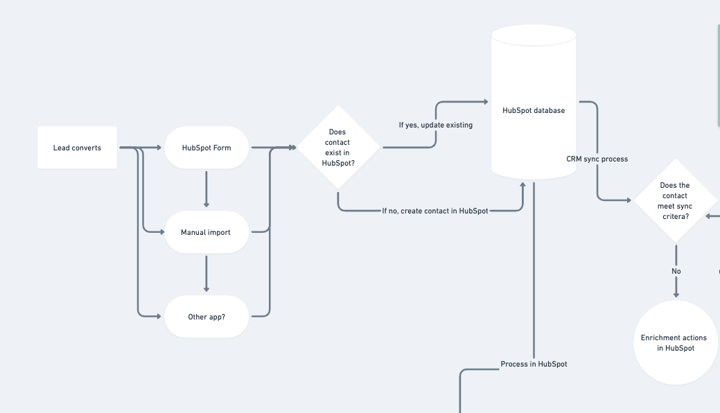How to Prioritize Your Revenue Operations Projects for B2B Companies
Prioritizing revenue operations projects can be a complex task when various departments within your organization are focused on different priorities. It is essential to ensure that all stakeholders across teams are available for collaboration, despite the inevitable urgent tasks or projects that need to be accommodated. I've most certainly fallen into the trap of putting out fires while not rewiring the house to actually prevent those fires from happening in the first place.
How should you go about prioritizing your projects?
1. What are your business goals?
Before you jump into prioritizing your revenue operations projects, take a step back and clearly define your business goals. Are you looking to increase revenue, improve customer retention, streamline your sales process, or perhaps all of the above? Understanding your objectives is the foundation for successful project prioritization and will help you align your projects accordingly.
By clearly defining your business goals, you can ensure that your revenue operations projects are strategically aligned with your overall business strategy. If your goal is to increase revenue, for example, you may prioritize projects that focus on improving lead generation or optimizing your sales funnel. On the other hand, if your goal is to improve customer retention, you may prioritize projects that enhance your customer success and support processes.
Having a clear understanding of your objectives will also help you communicate the importance and impact of your revenue operations projects to stakeholders within your organization. When everyone is on the same page regarding the overarching goals, it becomes easier to gain buy-in and collaboration from different departments and teams.
Furthermore, by defining your business goals, you can also identify any potential conflicts or trade-offs between different projects. For example, if you want to streamline your sales process to increase efficiency, but also prioritize a project to improve customer retention, you may need to find a balance between the two objectives.
Ultimately, understanding your business goals is the first step toward effective project prioritization. It provides a clear direction and purpose for your revenue operations projects, ensuring that they are aligned with your overall business strategy and have the greatest impact on your organization's success. So take a step back, define your goals, and let them guide your project prioritization process.
2. Analyze existing processes
Next, assess your current revenue operations processes by conducting a comprehensive analysis. Take a deep dive into your sales, marketing, and customer success operations to identify any bottlenecks, inefficiencies, or areas where revenue may be leaking. This could involve examining your lead generation process, evaluating the effectiveness of your sales funnel, or pinpointing any gaps in your customer success strategies.
During this assessment, it's crucial to identify pain points and challenges that hinder your revenue generation efforts. For example, if your lead generation process is lacking, you may discover that your marketing efforts are not effectively reaching your target audience or that your lead qualification process needs improvement. Similarly, if there are gaps in your sales funnel, you might find that leads are dropping off at certain stages or that your sales team needs additional training or resources.
By identifying these pain points, you can prioritize projects that directly address these issues and have the potential to significantly impact your revenue operations. For instance, if you identify that your lead generation process is lacking, you can prioritize a project to revamp your marketing strategies, invest in lead generation tools or technologies, or implement a lead scoring system to improve lead qualification.
Furthermore, assessing your current revenue operations processes allows you to gain a holistic understanding of your organization's strengths and weaknesses. It enables you to identify areas where you excel and can leverage existing processes, as well as areas where improvement is needed. This comprehensive analysis empowers you to make informed decisions about project prioritization and allocate resources effectively.
Remember, the goal of this assessment is to uncover pain points and areas of improvement within your revenue operations. By addressing these issues head-on, you can prioritize projects that will have the most significant impact on your revenue generation efforts and drive sustainable growth for your organization.
3. Map project impact
Now that you have a clear understanding of your goals and pain points, it's time to dive deeper into mapping out each project's potential impact. This step is crucial in determining which projects should take priority based on their potential return on investment (ROI), the time and resources required, and the overall impact on revenue.
When considering the potential ROI of a project, it's important to assess the expected financial gains and benefits that it can bring to your organization. Look at the projected increase in revenue or cost savings that can be achieved through the successful implementation of each project. Projects that promise a high return with manageable effort should be given higher priority as they can provide a quick boost to your bottom line.
In addition to ROI, you should also evaluate the time and resources required to execute each project. Take into account the manpower, technology, and budget needed to complete the project successfully. Consider the availability of your team and any external dependencies that may impact the timeline. Projects that require minimal resources or can be completed within a reasonable timeframe should be considered for prioritization.
While assessing the potential impact of each project, it's crucial to consider its overall effect on revenue generation. Evaluate how each project aligns with your business goals and whether it addresses the pain points identified during the analysis of your current revenue operations processes. Projects that directly address these pain points and have the potential to significantly impact your revenue operations should be given higher priority.
In summary, mapping out the potential impact of each project involves a careful evaluation of the potential ROI, the time and resources required, and the overall impact on revenue. By considering these factors, you can prioritize projects that offer the highest return with manageable effort, ensuring that your resources are allocated effectively to drive sustainable growth for your organization.
4. Consider time sensitivity
When considering the timing of revenue operations projects, it's important to recognize that not all projects are created equal in terms of urgency. Some projects may have a time-sensitive nature and need to be prioritized accordingly. For example, if your organization is planning a major sales push, it would make sense to prioritize implementing a new CRM system before the push begins. This way, your sales team can have the necessary tools and processes in place to effectively manage and track leads during the push.
In addition to internal factors, it's also crucial to take into account any external factors, deadlines, or market trends that may influence the urgency of a project. For instance, if there are industry-wide changes or advancements that could impact your revenue operations, you may need to prioritize projects that address these changes to stay competitive.
By considering the timing and urgency of each project, you can ensure that your efforts are aligned with the broader business landscape and that you are making the most effective use of your resources. Prioritizing time-sensitive projects allows you to seize opportunities, mitigate risks, and stay ahead of the curve in an ever-changing market.
In summary, when prioritizing revenue operations projects, it's important to consider the timing and urgency of each project. By taking into account internal and external factors, deadlines, and market trends, you can ensure that your projects are strategically aligned with your business objectives and have the greatest impact on your organization's success.
5. Involve stakeholders
In order to ensure the success of your revenue operations projects, it is essential to involve multiple stakeholders throughout the prioritization process. By engaging with your sales, marketing, and customer success teams, you can gain valuable insights into their pain points and priorities. This collaborative approach allows for alignment and ensures that the chosen projects are relevant and impactful for all parties involved.
By including stakeholders in the decision-making process, you foster a sense of ownership and buy-in from all departments. This not only increases the likelihood of successful project implementation but also promotes a culture of teamwork and collaboration within your organization. Each stakeholder brings their unique perspective and expertise, which can lead to innovative ideas and solutions that may not have otherwise been considered.
Additionally, involving stakeholders helps to manage expectations and address any potential concerns or resistance to change. By actively seeking their input, you demonstrate that their opinions and contributions are valued, which can help to overcome any resistance to new initiatives. This collaborative approach also allows for the identification of any potential conflicts or dependencies between projects, enabling you to make informed decisions and prioritize effectively.
In addition, involving stakeholders throughout the prioritization process guarantees that projects are in line with the overarching goals and objectives of the organization. By gaining a deep understanding of the challenges and priorities of each department, you can select projects that directly address their specific needs and contribute to their overall success. This alignment not only enhances the chances of project success but also fosters a sense of shared purpose and unity among all teams, creating a collaborative and cohesive work environment.
Involving stakeholders in the prioritization process is crucial for the success of revenue operations projects. By engaging with your sales, marketing, and customer success teams, you can gain valuable insights, foster collaboration, manage expectations, and ensure alignment with organizational goals. This inclusive approach will lead to relevant and impactful projects that drive sustainable growth and success for your organization.
6. Balance short-term and long-term goals
It can be tempting to prioritize projects that promise immediate revenue gains, but it's important not to overlook the long-term impact of your initiatives. Striking a balance between quick wins and projects that lay the foundation for sustainable growth is crucial for the overall success of your revenue operations.
While projects that deliver immediate results can provide a quick boost to your bottom line, it's equally important to invest in initiatives that have long-term benefits. These projects may not yield immediate revenue gains, but they can create a strong and stable foundation for sustainable growth in the future.
By prioritizing projects that have both immediate impact and long-term benefits, you can ensure that your organization is not only achieving short-term revenue goals but also setting itself up for long-term success. This balanced approach allows you to enjoy the immediate benefits of quick wins while simultaneously investing in projects that will contribute to your organization's sustained growth and profitability.
For example, while implementing a new lead generation strategy may not immediately generate a significant increase in revenue, it can lay the groundwork for a steady stream of high-quality leads in the long run. Similarly, improving your sales team's training and resources may not result in an immediate boost in sales, but it can enhance their skills and capabilities, leading to improved performance and revenue generation over time.
By finding a balance between short-term revenue gains and long-term growth initiatives, you can ensure that your organization is not only meeting its immediate goals but also positioning itself for continued success in the future. Prioritizing projects that offer both immediate impact and long-term benefits is the key to driving sustainable growth and maximizing your organization's revenue potential.
7. Start small and iterate
Lastly, it's crucial not to take on more than you and your team can handle. Instead of tackling numerous projects all at once, it's better to start small and gradually build upon your successes. Taking this approach allows for a more manageable workload and gives you the flexibility to monitor progress, make necessary adjustments, and course correct along the way.
By implementing changes in small, incremental steps, you can closely monitor the impact of each adjustment and gather valuable insights to inform future decisions. This iterative process enables you to identify what works and what doesn't, allowing you to refine your strategies and optimize your outcomes. It also helps you avoid overwhelming your team with too many changes all at once, ensuring that they have the time and resources to fully adapt and embrace the new initiatives.
Additionally, starting small and iterating allows for greater flexibility and agility in responding to unexpected challenges or opportunities. As you make incremental changes, you can easily pivot or adjust your course based on evolving market trends, customer feedback, or internal factors. This adaptability is essential in today's rapidly changing business landscape, where agility and responsiveness are key to maintaining a competitive edge.
In summary, adopting a start small and iterate approach not only prevents overwhelming your team but also enables better monitoring, adjustment, and course correction. By taking small, manageable steps, you can optimize your strategies, gather valuable insights, and maintain the flexibility needed to navigate the ever-changing business landscape effectively. So remember, don't bite off more than you can chew, and embrace the power of incremental progress for long-term success.
Remember, prioritizing revenue operations projects is an ongoing process. Regularly reassess your goals, analyze your processes, and involve stakeholders to ensure that your projects align with your business objectives. By focusing on the projects that will have the greatest impact on your revenue, you'll be well on your way to success. Happy prioritizing!
Do you need help with your upcoming Revenue Operations projects? Book a time on my calendar to chat.






